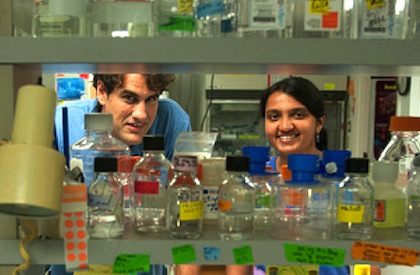A heart attack continues to harm cardiac muscle even after the immediate problem – a blocked artery – is fixed, but University of Vermont researchers have developed a new biologic drug that can preserve blood vessels critical to the body’s blood-pumping system.

Jeffrey Spees, Ph.D., Associate UVM professor of medicine, with former graduate student Krithika Rao, Ph.D.'15. (Photo: Alec Jacobson)
A heart attack continues to harm cardiac muscle even after the immediate problem – a blocked artery – is fixed, but University of Vermont researchers have developed a new biologic drug that can preserve blood vessels critical to the body’s blood-pumping system.
When an artery in the heart is clogged, toxic substances from cardiac tissue that has been deprived of oxygen and nutrients build up in the blood, similar to how the water that pools in front of a dam collects dirt and debris. To clear the blockage, doctors insert and expand a small mesh tube called a stent to help restore blood flow. Opening the blocked blood vessel that causes the heart attack – or myocardial infarction – is the aim, but there is a negative side effect: a cascade of blood filled with built-up toxins flows into the smaller downstream blood vessels. This damages the sensitive endothelial cells that line the microvasculature and capillaries.
Ultimately, this activity causes additional heart tissue to die and is commonly referred to as “reperfusion injury.” It’s collateral damage that’s nearly impossible to avoid, and the body doesn’t naturally restore the resulting dead or dying tissue, says University of Vermont Associate Professor of Medicine Jeffrey Spees, Ph.D. He and his colleagues have developed a therapy called VasaPlex – a protein complex that rescues some of the blood vessels and surrounding tissue at risk in animal models of heart attack. The National Heart, Lung and Blood Institute of the National Institutes of Health recently awarded Spees a $1.2 million R01 research grant to continue to test this invention.
“The first stuff to go downstream after the vessel is opened up is damaging,” Spees says. “If treatment with VasaPlex can preserve vessels downstream of the initial occlusion, we should be able to reduce infarct expansion and cardiac injury.”
VasaPlex consists of human Hepatocyte Growth Factor (HGF) and Immunoglobulin G (IgG).
“When concentrated together, these two things form a protein complex that is highly protective-- it keeps endothelial cells alive,” Spees says.
The goal would be for doctors to infuse VasaPlex into the coronary artery immediately following stent placement. In addition to signaling for cell survival, VasaPlex has properties that allow it to cling to the walls of vessels and injured tissue, rather than quickly break down before it can provide benefit.
Interventional cardiologists regularly use catheters and equipment that could deliver Vasaplex after stenting.
“Every time they restore flow to the coronary artery, they have the opportunity to release something that protects the downstream vasculature,” Spees says.
Spees and UVM have applied for a patent for VasaPlex, which also has potential applications for stroke and peripheral vascular disease.
Spees specializes in paracrine biology – the communication from one cell to another via a signal or secretion – which he describes as a “chemical song” that incites the body’s restorative cells to start a complicated dance. He has started a company, called Samba BioLogics, Inc., to develop products focused on the most crucial factors in that chemical song – a sort of MP3 version of its basic components.
Following his successful tests in rodent models, the new R01 grant will allow Spees to expand the testing of VasaPlex in a porcine model of myocardial infarction with reperfusion. He expects human clinical trials could start in three to four years.
“If we’re successful,” he says, “VasaPlex will become a drug that helps a significant number of people.”